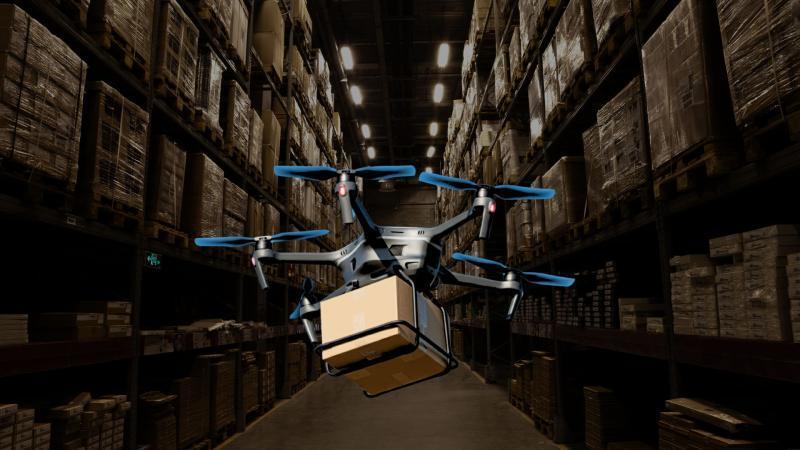
New Tech Optimises Drone Fleets for Faster, Greener Deliveries
Imagine receiving your packages in a fraction of the time it takes today, while also reducing the environmental impact of last-mile delivery. Sounds like a dream come true, right? Well, innovative research is making this a reality by tackling the Drone Warehouse Problem, a critical logistics challenge that has been holding back the adoption of drone delivery technology.
The Drone Warehouse Problem refers to the difficulty of managing and coordinating a fleet of drones from a central warehouse, ensuring that packages are delivered efficiently and effectively. With the increasing demand for fast and sustainable delivery options, finding a solution to this problem is crucial for logistics companies looking to stay ahead of the curve.
A recent breakthrough in research has led to the development of a novel algorithm that optimises drone delivery schedules, allowing warehouses to efficiently manage varied drone fleets and ensure that parcels reach customers quickly. This groundbreaking technology has the potential to revolutionise the way we think about last-mile delivery, making it faster, greener, and more scalable.
The Challenge of Drone Logistics
Drone delivery technology has been gaining traction in recent years, with companies like Amazon, UPS, and DHL investing heavily in the development of their own drone fleets. However, despite the promise of faster delivery times and reduced carbon emissions, the logistics of managing drone fleets have proven to be a significant challenge.
Traditional logistics systems are designed for ground transportation, not aerial delivery. The unique requirements of drone delivery, such as weather conditions, air traffic control, and payload capacity, make it difficult to coordinate and manage a fleet of drones. This has resulted in a bottleneck in the delivery process, with drones often waiting in queues or being grounded due to weather conditions.
A Novel Solution to the Drone Warehouse Problem
Researchers from [University Name] have developed a novel algorithm that addresses the Drone Warehouse Problem by optimising drone delivery schedules. The algorithm, known as the “Drone Fleet Optimisation Algorithm” (DFOA), uses advanced machine learning techniques to predict weather patterns, traffic congestion, and other factors that could impact drone delivery.
The DFOA algorithm works by creating a dynamic schedule for each drone, taking into account the specific requirements of each delivery. The algorithm considers factors such as the location of the delivery, the weight and size of the package, and the weather conditions at the time of delivery. By optimising the schedule in real-time, the DFOA algorithm ensures that each drone is used efficiently, reducing the risk of delays or cancellations.
Benefits of the DFOA Algorithm
The DFOA algorithm has several benefits that make it an attractive solution for logistics companies looking to improve their drone delivery operations. Some of the key benefits include:
- Faster Delivery Times: By optimising drone delivery schedules, the DFOA algorithm can reduce delivery times by up to 30%, making it an attractive option for companies looking to improve their customer satisfaction ratings.
- Reduced Carbon Emissions: With the DFOA algorithm, drones can fly more efficiently, reducing fuel consumption and carbon emissions. This makes it an attractive option for companies looking to reduce their environmental impact.
- Increased Scalability: The DFOA algorithm can be easily scaled up to manage large fleets of drones, making it an attractive option for companies looking to expand their drone delivery operations.
- Improved Safety: By reducing the risk of delays and cancellations, the DFOA algorithm can improve safety by reducing the risk of accidents and near-misses.
The Future of Drone Delivery
The DFOA algorithm has the potential to revolutionise the way we think about last-mile delivery, making it faster, greener, and more scalable. As the demand for fast and sustainable delivery options continues to grow, logistics companies will be looking for innovative solutions to stay ahead of the curve.
The DFOA algorithm is just one example of the many innovative technologies being developed to address the Drone Warehouse Problem. As the technology continues to evolve, we can expect to see even more efficient and effective solutions emerge.
Conclusion
The development of the DFOA algorithm is a significant breakthrough in the field of drone logistics, offering a practical solution to the Drone Warehouse Problem. With its ability to optimise drone delivery schedules, reduce delivery times, and improve safety, this technology has the potential to revolutionise the way we think about last-mile delivery.
As the world becomes increasingly dependent on fast and sustainable delivery options, companies will be looking for innovative solutions to stay ahead of the curve. The DFOA algorithm is just one example of the many exciting technologies being developed to address this challenge. As the technology continues to evolve, we can expect to see even more exciting developments in the world of drone logistics.
Source:
https://researchmatters.in/news/novel-algorithm-tackles-drone-warehouse-problem-faster-deliveries






